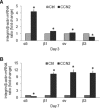Integrin expression and function in the response of primary culture hepatic stellate cells to connective tissue growth factor (CCN2)
- PMID: 20406330
- PMCID: PMC2912974
- DOI: 10.1111/j.1582-4934.2010.01072.x
Integrin expression and function in the response of primary culture hepatic stellate cells to connective tissue growth factor (CCN2)
Abstract
Production of connective tissue growth factor (CCN2, also known as CTGF) is a hallmark of hepatic fibrosis. This study examined early primary cultures of hepatic stellate cells (HSC) for (i) CCN2 regulation of its cognate receptor integrin subunits; and (ii) interactions between CCN2 and integrin α(5)β(1), heparan sulphate proteoglycans (HSPG) or fibronectin (FN) in supporting cell adhesion. HSC were isolated from healthy male Balb/c mice. mRNA levels of CCN2 or α(5), β(1), αv or β(3) integrin subunits were measured in days 1-7 primary culture HSC, and day 3 or day 7 cells treated with recombinant CCN2 or CCN2 small interfering RNA. Interactions between CCN2 and integrin α(5)β(1), HSPG or FN were investigated using an in vitro cell adhesion assay. Co-incident with autonomous activation over the first 7 days, primary culture HSC increasingly expressed mRNA for CCN2 or integrin subunits. Addition of exogenous CCN2 or knockdown of endogenous CCN2 differentially regulated integrin gene expression in day 3 versus day 7 cells. Either full length CCN2 ('CCN2(1-4)') or residues 247-349 containing module 4 alone ('CCN2(4)') supported day 3 cell adhesion in an integrin α(5)β(1) - and HSPG-dependent fashion. Adhesion of day 3 cells to FN was promoted in an integrin α(5) β(1)-dependent manner by CCN2(1-4) or CCN2(4), whereas FN promoted HSPG-dependent HSC adhesion to CCN2(1-4) or CCN2(4). These findings suggest CCN2 regulates integrin expression in primary culture HSC and supports HSC adhesion via its binding of cell surface integrin α(5)β(1), a novel CCN2 receptor in primary culture HSC which interacts co-operatively with HSPG or FN.
© 2011 The Authors Journal of Cellular and Molecular Medicine © 2011 Foundation for Cellular and Molecular Medicine/Blackwell Publishing Ltd.
Figures








Similar articles
-
Connective tissue growth factor (CCN2) induces adhesion of rat activated hepatic stellate cells by binding of its C-terminal domain to integrin alpha(v)beta(3) and heparan sulfate proteoglycan.J Biol Chem. 2004 Mar 5;279(10):8848-55. doi: 10.1074/jbc.M313204200. Epub 2003 Dec 17. J Biol Chem. 2004. PMID: 14684735
-
CCN2 promotes keratinocyte adhesion and migration via integrin α5β1.Exp Cell Res. 2013 Nov 15;319(19):2938-46. doi: 10.1016/j.yexcr.2013.08.021. Epub 2013 Aug 26. Exp Cell Res. 2013. PMID: 23988606
-
A novel integrin alpha5beta1 binding domain in module 4 of connective tissue growth factor (CCN2/CTGF) promotes adhesion and migration of activated pancreatic stellate cells.Gut. 2006 Jun;55(6):856-62. doi: 10.1136/gut.2005.079178. Epub 2005 Dec 16. Gut. 2006. PMID: 16361307 Free PMC article.
-
Regulation of hepatic stellate cells by connective tissue growth factor.Front Biosci (Landmark Ed). 2012 Jun 1;17(7):2495-507. doi: 10.2741/4067. Front Biosci (Landmark Ed). 2012. PMID: 22652794 Review.
-
Connective tissue growth factor (CCN2) in blood vessels.Vascul Pharmacol. 2013 Mar;58(3):189-93. doi: 10.1016/j.vph.2013.01.004. Epub 2013 Feb 4. Vascul Pharmacol. 2013. PMID: 23380714 Review.
Cited by
-
Dynamic Changes in Function and Proteomic Composition of Extracellular Vesicles from Hepatic Stellate Cells during Cellular Activation.Cells. 2020 Jan 25;9(2):290. doi: 10.3390/cells9020290. Cells. 2020. PMID: 31991791 Free PMC article.
-
Osteopontin, an oxidant stress sensitive cytokine, up-regulates collagen-I via integrin α(V)β(3) engagement and PI3K/pAkt/NFκB signaling.Hepatology. 2012 Feb;55(2):594-608. doi: 10.1002/hep.24701. Hepatology. 2012. PMID: 21953216 Free PMC article.
-
Effects of Ganfukang on expression of connective tissue growth factor and focal adhesion kinase/protein kinase B signal pathway in hepatic fibrosis rats.Chin J Integr Med. 2014 Jun;20(6):438-44. doi: 10.1007/s11655-013-1597-1. Epub 2013 Aug 29. Chin J Integr Med. 2014. PMID: 23990393
-
Tumorigenesis, diagnosis, and therapeutic potential of exosomes in liver cancer.J Hematol Oncol. 2019 Dec 9;12(1):133. doi: 10.1186/s13045-019-0806-6. J Hematol Oncol. 2019. PMID: 31815633 Free PMC article. Review.
-
The Influence of a Nanopatterned Scaffold that Mimics Abnormal Renal Mesangial Matrix on Mesangial Cell Behavior.Int J Mol Sci. 2019 Oct 28;20(21):5349. doi: 10.3390/ijms20215349. Int J Mol Sci. 2019. PMID: 31661773 Free PMC article.
References
-
- Iredale J. Defining therapeutic targets for liver fibrosis: exploiting the biology of inflammation and repair. Pharmacol Res. 2008;58:129–36. - PubMed
-
- Friedman SL. Stellate cells: a moving target in hepatic fibrogenesis. Hepatology. 2004;40:1041–3. - PubMed
-
- Reeves HL, Friedman SL. Activation of hepatic stellate cells–a key issue in liver fibrosis. Front Biosci. 2002;7:d808–26. - PubMed
-
- Rachfal AW, Brigstock DR. Connective tissue growth factor (CTGF/CCN2) in hepatic fibrosis. Hepatol Res. 2003;26:1–9. - PubMed
Publication types
MeSH terms
Substances
Grants and funding
LinkOut - more resources
Full Text Sources
Other Literature Sources
Miscellaneous

